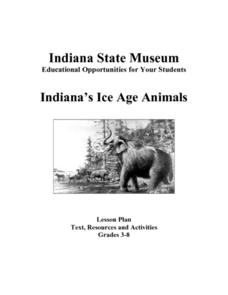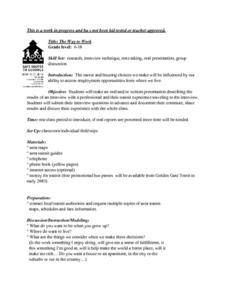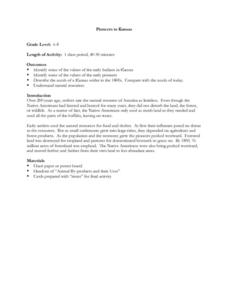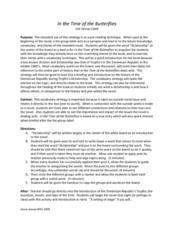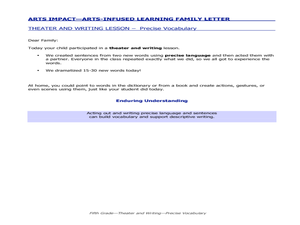Curated OER
Children Using Antonyms to Write Short Stories
Second graders discuss what antonyms are and read the book, Quick as a Cricket. In this antonym lesson, 2nd graders write a short story by describing themselves.
Curated OER
Publishing Stories: Beginning, Middle, End
First and second graders explore the importance of having a beginning, middle, and end when writing stories. For this story writing lesson, pupils write short stories using the story diamond as a guide. They invite their parents to an...
Curated OER
Field Trip to the Watsonville Wetlands
Students explore the differences between food webs and food chains. In this wetland lesson students play a food web game and go on a scavenger hunt.
Curated OER
My Autobiography Activity
Second graders tell others about themselves. In this autobiography lesson, 2nd graders respond to questions about themselves and then create pictures that reveal their personalities.
Curated OER
Sentence Match
Fifth graders explore the concept of equivalency. In this math lesson, 5th graders write their own word problems and pair them to appropriate algebraic number sentences.
Curated OER
Life and change in Northern Ireland
Students read about life and changing times in Northern Ireland and match questions to answers. In this reading lesson plan, students also look up places they can visit in Northern Ireland and write what they would like to do there.
Curated OER
Things That Glow: From Fireflies to Quantum Dots
Third graders observe light energy. For this heat and energy lesson, 3rd graders will study the concept of light as a form of energy. Students will examine the different forms of light and the type of energy it produces.
Curated OER
Use synonyms to make your writing vivid
Students examine synonyms and practice finding appropriate synonyms in a thesaurus. For this use synonyms to make your writing vivid lesson, students identify the correct usage of synonyms. Students replace incorrect synonyms in...
Curated OER
Trees
Fourth graders discuss the function of roots, trunk, crown, bark, cambium heartwood, and leaves of a tree. They create a tree diagram and label roots, trunk, crown, bark, cambium heartwood and leaves when shown a list of parts and an...
Curated OER
West Virginia Quarter Reverse: Over, Under, In, and Out
Students examine the images on the West Virginia quarter reverse. Using the quarter design as a model, the discover the meaning of directional terms. They play a game where they have to listen to and follow directions and complete a...
Curated OER
"Living in the Limelight The Universal Dream"
High schoolers, using Leo's Lyrics, investigate common themes in popular music. They create a Microsoft Excel spreadsheet that analyzes their findings along with a 200 word paragraph stating their observations, conclusions and hypotheses...
Curated OER
Japanese Culture--Comparing the Japanese Educational System to the American
Students study the Japanese educational system and compare and contrast it to the American system. They discuss a typical school day in America and what they believe a typical day is for a Japanese student. Next they write an editorial...
Curated OER
The Way to Work
Young scholars make oral and/or written presentations describing results of interviews with professionals and their transit experiences traveling to the interviews.
Curated OER
Pioneers to Kansas
Students investigate items for basic survival, needed for survival, and luxury items. They compare what they need to what Indians and Pioneers needed in the 1700's and 1800's.
Curated OER
Line Up! Shape Up! Color the World!
Students explore the Elements of Art. In this art lesson, students read the book Katie Meets the Impressionists and brainstorm the different things that artists create. Students observe various elements of art such as line and color and...
Curated OER
Identifying the Beat
Sixth graders listen to various songs. In this musical properties lesson, 6th graders work in groups to identify musical selections, practice tapping the beat, review time signatures, and identify the meter of different songs.
Curated OER
Persona Interests, Likes, and Dislikes
Students practice listening to and discussing their personal interests and opinions. In this communication lesson, students listen as the teacher talks about his/her personal interest. They work with a partner to verbally share their own...
Curated OER
In the Time of Butterflies: List-Group-Label
Use the list-group-label strategy to introduce your class to In the Time of the Butterflies by Julia Alvarez. The teacher begins by writing a word on the board (dictatorship is suggested here), and then the kids write as many words as...
Curated OER
Vocabulary
Fourth graders classify vocabulary words by category. Through matching and classification activities, 4th graders sort words pertaining to trees and forest habitats into appropriate categories. They discuss how vocabulary practice can...
Curated OER
Precise Vocabulary
Students complete acting exercises as a part of a precise language activity to help them build vocabulary and improve their descriptive writing skills. In this theatre and writing lesson, students create and act out a sentence with two...
Curated OER
Using Context Clues
Teach your third graders how to find the meanings of words using context clues. Using this reading lesson, discuss how readers can find the meaning of a word by using the sentences around it. They then complete a worksheet in which they...
Curated OER
Introducing the Hamburger Model or Persuasive Writing
A one-page template provides primary writers with a graphic organizer to assist them in drafting a persuasive paragraph. Labeled the “Hamburger Model” because of its appearance, the worksheet asks pupils to craft an introduction, provide...
Curated OER
Story Structure Slide Show
Analyzing the sequence of actions in dramatic stories leads to deeper comprehension of story structure. The class identifies the main actions in each section of a story and develops frozen tableau's for the identified actions of the...
Curated OER
Literary Terms Used in I, Juan de Pareja
Seventh graders define six different literary terms after reading I, Juan de Pareja. In groups, they are given a specific literary term to create a PowerPoint presentation explaining how their term in utilized in the context of I, Juan...











